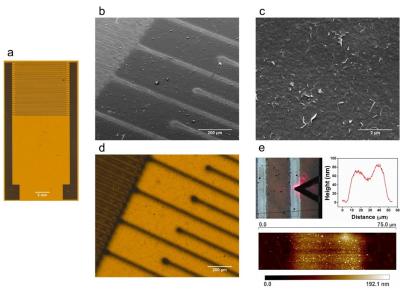Researchers at Iowa State University and Northwestern University have developed graphene sensors that are printed with high-resolution aerosol jet printers on a flexible polymer film and tuned to test for histamine, an allergen and indicator of spoiled fish and meat.
 Image courtesy of Jonathan Claussen, taken from Iowa State University's website
Image courtesy of Jonathan Claussen, taken from Iowa State University's website
The U.S. Food and Drug Administration has set histamine guidelines of 50 parts per million in fish, while the sensors were found to detect histamine down to 3.41 parts per million. This validates that the sensors are more than sensitive enough to track food freshness and safety.
This fine resolution is important, said Jonathan Claussen, an associate professor of mechanical engineering at Iowa State University and one of the leaders of the research project. The closer we can print these electrode fingers, in general, the higher the sensitivity of these biosensors.
The paper describes how graphene electrodes were aerosol jet printed on a flexible polymer and then converted to histamine sensors by chemically binding histamine antibodies to the graphene. The antibodies specifically bind histamine molecules.
The histamine blocks electron transfer and increases electrical resistance, the team said. That change in resistance can be measured and recorded by the sensor.
This histamine sensor is not only for fish, said Carmen Gomes, an associate professor of mechanical engineering at Iowa State. Bacteria in food produce histamine. So it can be a good indicator of the shelf life of food.
The researchers believe the concept will work to detect other kinds of molecules, too.
Beyond the histamine case study presented here, the (aerosol jet printing) and functionalization process can likely be generalized to a diverse range of sensing applications including environmental toxin detection, foodborne pathogen detection, wearable health monitoring, and health diagnostics, they wrote in their research paper.
For example, by switching the antibodies bonded to the printed sensors, they could detect salmonella bacteria, or cancers or animal diseases such as avian influenza, the researchers wrote.

